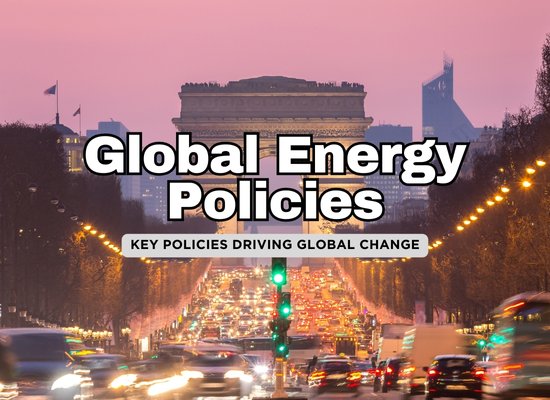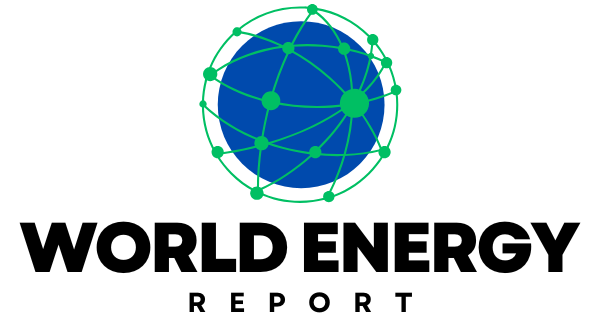The 5 Big Energy Policies Shaping the Future (simplified)

The global energy landscape isn’t just shaped by technology and market trends—it’s heavily influenced by policies and regulations. Some policies aim to accelerate the transition to renewables, while others protect fossil fuel interests or navigate geopolitical energy security. These five major energy policies are playing a critical role in shaping the future of energy worldwide.

1️⃣ The Paris Agreement: The Global Climate Commitment
The Paris Agreement is a landmark international treaty adopted in 2015, bringing together nearly 200 countries with a shared goal: limit global warming to well below 2°C, ideally 1.5°C above pre-industrial levels. It’s the world’s most important climate agreement, but its success depends on how well countries implement their pledges.
How It Works
- Every participating country sets its own Nationally Determined Contributions (NDCs)—essentially self-imposed carbon reduction targets.
- These goals are reviewed every five years in a process called the Global Stocktake, meant to push countries toward more ambitious climate action.
- Developed nations provide financial aid to developing countries to help them transition to cleaner energy and adapt to climate impacts.
Importance
- Many governments have aligned their policies with the Paris Agreement, introducing stricter emissions laws and phasing out coal plants.
- It’s driving massive investments into renewable energy, electric vehicles, and energy efficiency.
- Global markets now factor climate commitments into business and investment decisions, affecting everything from carbon trading to oil prices.
Challenges & Criticisms
- Since NDCs are voluntary, there are no real penalties for failing to meet targets. Some countries, including major polluters, aren’t on track.
- Many governments set long-term targets (like net-zero by 2050) but delay short-term action, raising doubts about whether these goals will be met.
- Wealthier nations haven’t fully delivered on their climate finance promises, leaving poorer countries struggling to make the green transition.
The Paris Agreement set the direction, but the real battle is in implementation—watch how individual countries enforce their commitments to see its full impact.
2️⃣ The European Green Deal: The EU’s Plan for a Climate-Neutral Economy
The European Green Deal is the most ambitious climate policy package in the world, aiming to make the European Union climate-neutral by 2050. It’s not just about reducing carbon emissions—it’s a complete economic transformation that affects energy, transportation, industry, and even agriculture.
How It Works
- Massive Renewable Energy Expansion – The EU is scaling up wind, solar, and hydrogen energy while phasing out coal and reducing reliance on natural gas.
- Carbon Border Adjustment Mechanism (CBAM) – This is a carbon tax on imports, meaning foreign companies exporting to Europe must meet EU climate standards or pay a fee.
- Energy Efficiency Targets – New regulations require industries and households to improve energy efficiency in buildings, factories, and vehicles.
- Emission Reductions in Every Sector – From aviation to shipping, the EU is tightening emissions laws to push businesses toward cleaner alternatives.
Importance
- It’s influencing global trade – Countries exporting to Europe are being forced to comply with EU climate regulations, even if their own governments don’t have strict policies.
- It’s accelerating clean energy investments – European businesses are getting billions in funding for green energy, battery technology, and climate-friendly manufacturing.
- It’s setting a global standard – Many countries outside the EU are adopting similar policies to remain competitive in global markets.
Challenges & Criticisms
- Higher energy costs – The transition away from fossil fuels has led to short-term price spikes, causing backlash from industries and consumers.
- Economic strain on certain sectors – Energy-intensive industries like steel, cement, and chemicals are struggling with rising costs due to stricter regulations.
- Political pushback – Some governments argue that the pace of change is too fast, and farmers and businesses are protesting new environmental laws.
The European Green Deal is a blueprint for global climate action, but its long-term success depends on balancing economic growth with sustainability.
3️⃣ The Energy Charter Treaty (ECT): Protecting Investments or Blocking Climate Action?
The Energy Charter Treaty (ECT) was originally designed to protect international energy investments, ensuring that companies investing in oil, gas, and electricity generation wouldn’t lose money due to political instability, expropriation, or sudden policy changes. However, in recent years, it has become one of the most controversial treaties in the energy world.
How It Works
- Investment Protection – The ECT allows energy companies to sue governments if they believe policy changes (like new environmental laws or fossil fuel bans) unfairly reduce their profits.
- Covers Fossil Fuels and Renewables – Originally created to encourage oil and gas investments in former Soviet states, it now covers renewables, nuclear, and emerging energy sectors.
- Investor-State Dispute Settlement (ISDS) – This mechanism allows companies to file billion-dollar lawsuits against governments for changing energy policies.
Importance
- It’s slowing climate action – Some companies are using the ECT to sue governments for phasing out fossil fuels, making it harder to transition to green energy.
- It protects energy security – Supporters argue that the ECT is crucial for attracting investments in renewables, as companies need assurance their projects won’t be shut down without compensation.
- Countries are leaving – The EU, France, Spain, Germany, and the Netherlands have announced plans to exit the treaty, arguing that it conflicts with climate goals.
Challenges & Criticisms
- Blocking green policies – Fossil fuel companies have used the treaty to challenge coal and gas phaseouts, arguing that it violates their investment rights.
- Expensive legal battles – Governments have faced multi-billion-dollar lawsuits for implementing climate-friendly policies.
- A push for reform – There have been attempts to modernize the ECT to align with the Paris Agreement, but progress has been slow.
The Energy Charter Treaty was meant to protect investments, but in today’s energy transition, it’s becoming a battleground between fossil fuel interests and climate policies.
4️⃣ National Energy Policies: Countries Setting Their Own Rules
While global agreements like the Paris Agreement and European Green Deal set broad targets, each country has its own energy policies that determine how fast (or slow) they transition to cleaner energy. Some nations are leading the charge on renewables, while others are still pushing fossil fuels for economic or political reasons.
How It Works
- Governments set national targets – Some countries aim for net-zero by 2050, while others focus on short-term economic gains from fossil fuels.
- Subsidies & Incentives – Nations offer financial support for renewables, nuclear, and emerging energy tech (or, in some cases, still subsidize oil and gas).
- Regulations & Taxes – Countries impose carbon taxes, emissions limits, and clean energy mandates to shape energy production and consumption.
Importance
- United States – The U.S. is split on energy policy. The Inflation Reduction Act (IRA) offers huge subsidies for clean energy, but some states still push for more oil and gas production.
- China – China is the biggest renewables investor but also the largest coal consumer, creating a contradictory energy strategy.
- United Kingdom – The UK is phasing out coal and investing heavily in offshore wind, but rising energy prices are challenging public support.
- India & Emerging Markets – Countries like India, Brazil, and Indonesia are expanding renewables, but rely on fossil fuels for economic growth.
Challenges & Criticisms
- Policy reversals – When governments change, energy policies shift, creating uncertainty for investors.
- Balancing economy & environment – Some nations fear that too-fast green transitions will hurt industries and jobs.
- Global inconsistencies – No two countries have the same plan, making coordinated global action difficult.
National policies set the real pace of the energy transition, and while some countries are going all-in on renewables, others aren’t ready to let go of fossil fuels just yet.
5️⃣ Trade Policies and Energy Security: Who Controls the Supply?
Global energy trade is a high-stakes geopolitical game. Countries that control oil, gas, and key minerals hold massive influence, while others scramble to secure their energy future. Recent conflicts, economic shifts, and supply chain disruptions have pushed energy security to the top of global priorities.
How It Works
- Tariffs and Trade Barriers – Some nations impose taxes on energy imports to protect domestic industries or reduce reliance on foreign suppliers.
- Export Controls on Key Resources – Countries with critical minerals (like lithium, cobalt, and rare earths) restrict exports to keep supplies for themselves or gain leverage in trade negotiations.
- Energy Alliances & Sanctions – Countries form agreements to secure energy access, while others use sanctions to cut off supply to rivals.
Importance
- Russian Energy & Europe – After the Ukraine war, Europe drastically cut Russian gas imports, shifting toward renewables and LNG from the U.S.
- China’s Grip on Minerals – China dominates the global supply of rare earth metals, crucial for batteries, solar panels, and wind turbines, creating a new energy dependency.
- The U.S. Inflation Reduction Act – The U.S. is pushing for domestic energy independence, investing heavily in American-made clean energy technologies.
- OPEC’s Role in Oil Markets – Oil-producing countries in OPEC control supply and prices, often limiting production to drive prices up.
Challenges & Criticisms
- Energy nationalism – Countries are hoarding resources, making global cooperation more difficult.
- Unstable supply chains – The push for renewables requires huge amounts of critical minerals, but supply is concentrated in a few key nations.
- Political tensions – Trade wars and conflicts disrupt energy access, creating price spikes and economic uncertainty.
Energy is no longer just a commodity—it’s a weapon, a bargaining chip, and a geopolitical tool that shapes the world economy.
The world’s energy future is being shaped by a mix of global agreements, national strategies, and trade conflicts. While policies like the Paris Agreement and the European Green Deal aim for a cleaner future, challenges like energy security, resource shortages, and political resistance slow progress.
The big question: Will the world move fast enough toward clean energy, or will old industries and geopolitical tensions keep fossil fuels in play longer than expected?
The coming years will decide how the energy transition plays out, and smart investors, businesses, and governments will need to stay ahead of these shifts.
Article Summary
| WorldEnergyReport: 5 Major Policies Shaping Global Energy | |||
|---|---|---|---|
| Policy | What It Does | Importance | Challenges |
| Paris Agreement | Global climate pact to cut emissions and limit warming. | Encourages renewable energy investments and global cooperation on climate policies. | No enforcement mechanism, voluntary targets, and some countries lagging on commitments. |
| European Green Deal | EU-wide policy to achieve net-zero emissions by 2050. | Boosts clean energy, imposes carbon tariffs, and pushes businesses to go green. | Higher energy costs, industry resistance, and political pushback in some EU nations. |
| Energy Charter Treaty (ECT) | Protects energy investments by allowing companies to sue governments. | Originally meant to secure investments, but now seen as blocking climate policies. | Many EU countries are leaving due to lawsuits preventing fossil fuel phase-outs. |
| National Energy Policies | Each country sets its own rules for energy production and consumption. | Decides the pace of renewable adoption and fossil fuel reliance. | Frequent policy reversals based on elections and economic factors. |
| Trade Policies & Energy Security | Regulates imports, exports, and controls over critical energy resources. | Shapes global energy markets, affects prices, and influences supply chains. | Tensions over resource control, supply chain disruptions, and trade disputes. |
